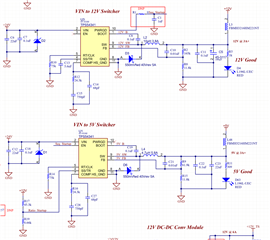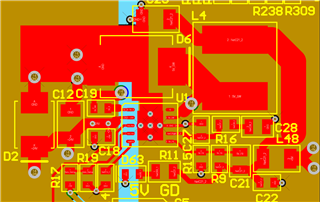Other Parts Discussed in Thread: TPS54360
Hello,
I am using two TPS54341 components in my design, one for 24V-to-12V regulation and one for 24V-to-5V regulation. I have them configured for ratiometric startup and have simulated both using WEBENCH to get ballpark compensation components. Please see attached schematic snippet. Also please note there is another 100uF on the 5V rail at a different connector.
The 12V regulator looks fine, I've loaded its output with up to 2A and it seems stable. Startup conditions look good.
The 5V regulator however is producing higher output voltages with added load (steady state). At no significant load, it's at around 5.2V (which seems a little high but close enough
 ). As I add resistive load to the 5V output (0.5A, 1A), its output voltage increases. With a 1A constant load, it rises to 5.8V.
). As I add resistive load to the 5V output (0.5A, 1A), its output voltage increases. With a 1A constant load, it rises to 5.8V.
I have tried re-simulating, swapping out different values for compensation per the simulation (which says it should be stable), and also just in case, removed the ratiometric components and replaced with a Css of just 2.7nF. The 4.7uH inductor is rated for 5.8A, it's part number is: SRN8040TA-4R7M.
I've run out of things to test and look at, the rising output voltage has me baffled. Any ideas? I did PCB layout per the datasheet and kept things clean. Please see attached screenshot of the 5V regulator PCB layout.
Thank you so much in advance for any feedback you can provide!
Jason Metzner




